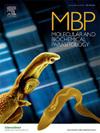利什曼原虫表面分子:从毒力决定因素到治疗和疫苗靶点。
IF 1.5
4区 医学
Q4 BIOCHEMISTRY & MOLECULAR BIOLOGY
引用次数: 0
摘要
利什曼病是一组被忽视的热带病(NTDs),由利什曼属原虫引起,影响热带和亚热带地区的脆弱人群。本病临床表现为皮肤、粘膜和内脏。这一重大公共卫生疾病发病率很高,尽管利什曼病影响全球,但可用的治疗选择很少,目前也没有获得许可的人用疫苗。此外,现有的治疗药物具有高毒性和治疗失败的特点。这些限制突出了确定新的治疗靶点的重要性,这将有助于开发更有效、更安全、更短的治疗方案。在这种情况下,利什曼原虫的表面分子由于其在宿主细胞粘附、免疫逃避和细胞内存活中的作用而成为有吸引力的治疗靶点。除了它们在药物发现和疫苗开发中的翻译潜力外,这些表面分子是在寄生虫生物学和疾病发病机制中发挥核心作用的关键毒力因子。了解它们的结构和功能不仅对阐明宿主-寄生虫相互作用的机制,而且对确定新的治疗和预防策略至关重要。重要的是,GP63(一种主要的表面金属蛋白酶)、LPG(脂磷酸聚糖)和KMP-11(动质体膜蛋白11)等分子结合了基本的生物学功能和已证实的免疫原性,使它们有望成为化疗和预防性干预的靶点。本文旨在探讨利什曼原虫主要表面毒力因子的结构和功能特征,强调它们在寄生虫-宿主相互作用中的作用,并讨论它们在治疗和疫苗开发中的转化潜力。本文章由计算机程序翻译,如有差异,请以英文原文为准。
Surface molecules of Leishmania: From virulence determinants to therapeutic and vaccine targets
Leishmaniasis is a group of neglected tropical diseases (NTDs) caused by protozoa of the genus Leishmania that affect vulnerable populations in tropical and subtropical regions. The disease manifests in cutaneous, mucocutaneous, and visceral clinical forms. This major public health disease presents high morbidity, and despite the global impact of leishmaniasis, there are few therapeutic options available and no currently licensed human vaccines. Besides, the available therapeutic agents are associated with high toxicity and treatment failure. These limitations highlight the importance of identifying new therapeutic targets, which will contribute to the development of more effective, safer and shorter treatment options. In this context, surface molecules of Leishmania emerge as attractive therapeutic targets due to their roles in host cell adhesion, immune evasion, and intracellular survival. In addition to their translational potential for drug discovery and vaccine development, these surface molecules are key virulence factors that play central roles in parasite biology and disease pathogenesis. Understanding their structure and function is essential not only for elucidating mechanisms of host–parasite interaction, but also for identifying novel therapeutic and prophylactic strategies. Importantly, molecules such as GP63 (a major surface metalloprotease), LPG (lipophosphoglycan), and KMP-11 (kinetoplastid membrane protein 11) combine essential biological functions with demonstrated immunogenic properties, making them promise as targets for both chemotherapeutic and prophylactic interventions. This review aims to explore the structural and functional characteristics of major surface virulence factors in Leishmania, highlighting their roles in the parasite–host interaction and discussing their translational potential for therapeutic and vaccine development.
求助全文
通过发布文献求助,成功后即可免费获取论文全文。
去求助
来源期刊
CiteScore
2.90
自引率
0.00%
发文量
51
审稿时长
63 days
期刊介绍:
The journal provides a medium for rapid publication of investigations of the molecular biology and biochemistry of parasitic protozoa and helminths and their interactions with both the definitive and intermediate host. The main subject areas covered are:
• the structure, biosynthesis, degradation, properties and function of DNA, RNA, proteins, lipids, carbohydrates and small molecular-weight substances
• intermediary metabolism and bioenergetics
• drug target characterization and the mode of action of antiparasitic drugs
• molecular and biochemical aspects of membrane structure and function
• host-parasite relationships that focus on the parasite, particularly as related to specific parasite molecules.
• analysis of genes and genome structure, function and expression
• analysis of variation in parasite populations relevant to genetic exchange, pathogenesis, drug and vaccine target characterization, and drug resistance.
• parasite protein trafficking, organelle biogenesis, and cellular structure especially with reference to the roles of specific molecules
• parasite programmed cell death, development, and cell division at the molecular level.

 求助内容:
求助内容: 应助结果提醒方式:
应助结果提醒方式:


